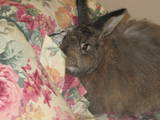I’ve always had lop-eared rabbits until Fuzz, a Jersey Wooley, and Muffy, an angoracross, came to live with me. Used to caring for short-coated rabbits, I soon learned that Muffy and Fuzz were going to require a bit more grooming than what I was accustomed to providing.
I also quickly learned that, contrary to what many believe, not all long-haired rabbits like to be groomed. In fact, Muffy and Fuzz would be quite happy to never be groomed. However, given the nature of their coats, regular grooming is a must. Hopefully, with some patience, practice and the tips provided in this article, bunny owners will be able to make grooming time less stressful for both themselves and their rabbits.
The Long-haired Breeds:
There are several kinds of ‘wooled’ or long haired rabbits, including several breeds of angoras, the Fuzzy Lop and the Jersey Wooley. Although they all have long hair, their fur differs in texture due to the number of guard hairs (the fur that is stronger and straighter than the awn fluff and undercoat) that are present. Fewer guard hairs mean a softer coat that tangles easier and is much more difficult to maintain. English Angoras have very few guard hairs, while French Angoras have the most guard hairs: thus French Angoras have the easist of the angora coats to care for.
fur differs in texture due to the number of guard hairs (the fur that is stronger and straighter than the awn fluff and undercoat) that are present. Fewer guard hairs mean a softer coat that tangles easier and is much more difficult to maintain. English Angoras have very few guard hairs, while French Angoras have the most guard hairs: thus French Angoras have the easist of the angora coats to care for.
Keeping Your Long-haired Beauty Looking Its Best:
The wooled breeds are not recommended for anyone who doesn’t want to groom or who doesn’t have time to groom. Grooming time for these beauties can range from a few minutes to more than an hour per week, depending upon the breed and quality of the wool.
For a rabbit that is severely matted, it is recommended that a rabbit savvy veterinarian or a professional groomer with rabbit experience shave the rabbit, or at least the very matted parts. A #40 blade is preferred, as rabbit fur is very fine and easily clogs up the clippers and blade. After being shaved, fur should then be groomed regularly to prevent further matting. Depending upon the severity of the mats, the shaving process may take several hours and the rabbit may need to be sedated to minimize stress.
If you do not choose to have the matted parts shaved, it is recommended that you work on one section per day, being cautious not to stress or tire the rabbit. Take your fingers and gently pull the mats apart or snip into them with sharp, blunt scissors while holding your fingers between the bottom of the mat and the rabbit’s skin to avoid cutting into the skin. As you pull or cut the mats apart, gently comb through the mat with a metal comb to remove lose fur.
IMPORTANT: Do not pull the mat up when cutting into it!
Pulling on the mat also pulls the skin up, making it easy to cut into the skin with your scissors.
Recommended Tools:
Mat Rake.
A good mat rake to try is the E-jay Rakom R-2, which can be ordered through your veterinarian, or simply a metal comb, preferably one where the teeth spin (the spinning teeth go through tangles easier). A slicker brush is not recommended because the bristles are sharp and too rough on the skin. In addition, slicker brushes only go through the top layer of fur, which doesn’t mat.
The Technique:
Since mats form in the undercoat and not in the top layer of fur, lift the fur and brush it layer by layer, starting at the deepest layer. This task is easiest if the layers are small. Hold the layer of fur at the base to prevent pulling on the fur too hard, which can cause discomfort or tears to the rabbit’s delicate skin.
To groom the neck and chest area, gently move the fur to one side and comb it, keeping in mind that most rabbits do not like to be touched under the chin. Some rabbits will lie on their back and allow their owners to groom their underside, if groomed this way from a young age. In reality, though, most rabbits probably find being groomed this position stressful. It is probably better to have these areas shaved as needed or, if you have a helper, have them hold the rabbit while you brush the underside.
Mats typically occur around the side of the face, along the bottom of the rabbit on each side, on the belly, between the front and back legs or on the rear end around the tail, so when you groom your rabbit, pay close attention to these areas. Be careful not to cut your rabbit’s tail if you use scissors to remove mats from this area.
In addition, some rabbits also form mats on their feet. Small mats can be left intact, but larger mats or mats that affect how your rabbit hops or affect your rabbit’s natural sitting position should be removed. Cut out larger mats using sharp, blunt scissors. If you cut a mat off, be careful to only cut the mat and not the fur on the bottom of the foot.
Plucking:
Plucking is another grooming technique where by you remove the ‘dead’ wool by holding the fur at the base and gently drawing it up through your fingers. Plucking does not hurt the rabbit because wool that is ready to be plucked has already been released from the skin. When the wool is ready to be plucked, itwill easily come out. If the
wool is not plucked when it is ready, mats will form.
(Note: German Angoras do not release their wool and should not be plucked).
Generally, your rabbit should be plucked every three months or whenever you start to see wisps of hair in the corners of the cage. If you pluck your rabbit regularly, you will start to notice that the new hair will be shorter than the old.
Grooming Tips:
- If your rabbit has really long fur, it is helpful to keep the rabbit clipped short. Ideally, fur should be kept at a length of 1″ or less. Use blunt, sharp grooming scissors to trim your rabbit and remember to keep your fingers between the scissors and the rabbit’s skin.
- Professionals use pet blowers to blow the coat, ridding it of dander, dust and lose fur, which contribute to matting. A hair dryer on the coolest setting also works if your pet is not stressed by the noise. A hair dryer can be particularly helpful in locating the ‘webbed’ areas of fur, or those areas about to become really matted. If you use a dryer on your pet’s fur, do not use it on the face or ears.
- To help loosen mats, sprinkle cornstarch baby powder (NOT talc powder) onto the mats, let set briefly then gently pull the mats and part and comb or brush.The cornstarch acts as a gentle, nontoxic lubricant.
- For mats that are close to the skin, it is best to allow the mat to grow out a bit until it can be safely cut out or removed.
- Your rabbit is more likely to hold still if you groom him in a slightly unfamiliar place, a towel on top of a waist-high table, for example. If the rabbit will sit still, you can also hold it sideways on your lap with the rabbit’s head tucked under your arm.
Dietary Considerations:
Generally, long-haired rabbits require more protein and energy than their shortcoatedcousins because their coats are constantly growing. For this reason, timothy based pellets are generally not the best choice for long-haired rabbits, but can be fed if the rabbit maintains its weight and does well on them. From www.carrotcafe.com (by Laura
Atkins): “Because of their higher protein requirement, angoras can be fed small amounts of alfalfa hay if calcium intake is not a problem”.
Adding extra protein and calories to an angora’s diet can be a problem if he is bonded to a short-coated rabbit or one with weight or calcium issues. If this is the case, you may choose to supplement the angora’s diet with small hand-fed treats, such as an occasional sunflower seed, a handful of alfalfa hay or a pinch of whole oats. The supplement choice should depend upon what your rabbit tolerates best and whether or not he has issues with calcium, soft stools or weight gain.
Housing Considerations:
A common misconception is that longhaired rabbits are suitable for outdoor living in cool climates. In reality, angoras are probably the most unsuitable rabbit for outdoor living. If not groomed properly, the long fur can become tangled and caught on bushes if the rabbit is allowed to run in a garden. In addition, the fur around the genital area can collect urine and feces, creating an unsanitary condition, which attracts flies and maggots. Even with long fur, it is difficult to keep angora rabbits warm enough in the winter in our harsh climate. It should also be noted that long-haired breeds tend to be particularly intolerant of the summer heat.
Generally, long-haired rabbits require the same kind of indoor housing arrangements as short-haired rabbits. Even with the thick fur on the feet, it is still essential to cover wire floored cage bottoms with a solid resting place to prevent sore hocks. Yesterday’s News and woodstove pellets are good choices for litter box filler because litters such as
Carefresh and Aspen shavings stick to a long-haired rabbit’s fur and be tracked all over your house.
Hay, if used in the litter box, is also more likely to stick to your long haired rabbit’s fur. However, since your rabbit should be encouraged to eat as much hay as possible, it is best to put the litter box on linoleum or tile and keep a whisk broom handy!
Other Things to Think About:
- Long-haired rabbits should be frequently and carefully checked for abscesses
and skin abnormalities, etc, because these problems are more difficult to see on
a long-haired rabbit than on a short-haired rabbit. - Having a long-haired rabbit does not necessarily mean that you will have to
vacuum more frequently. Short-haired rabbits have the potential to shed as much
as long-haired rabbits. - If your long-haired rabbit is bonded to a rabbit who likes to groom,
regularly removing loose fur is especially important to prevent both rabbits
from ingesting excess fur during grooming. - And, finally, Muffy and Fuzz feel that a few treats go a long way in making
thegrooming process a little more pleasant.
by Pam Rothwell

